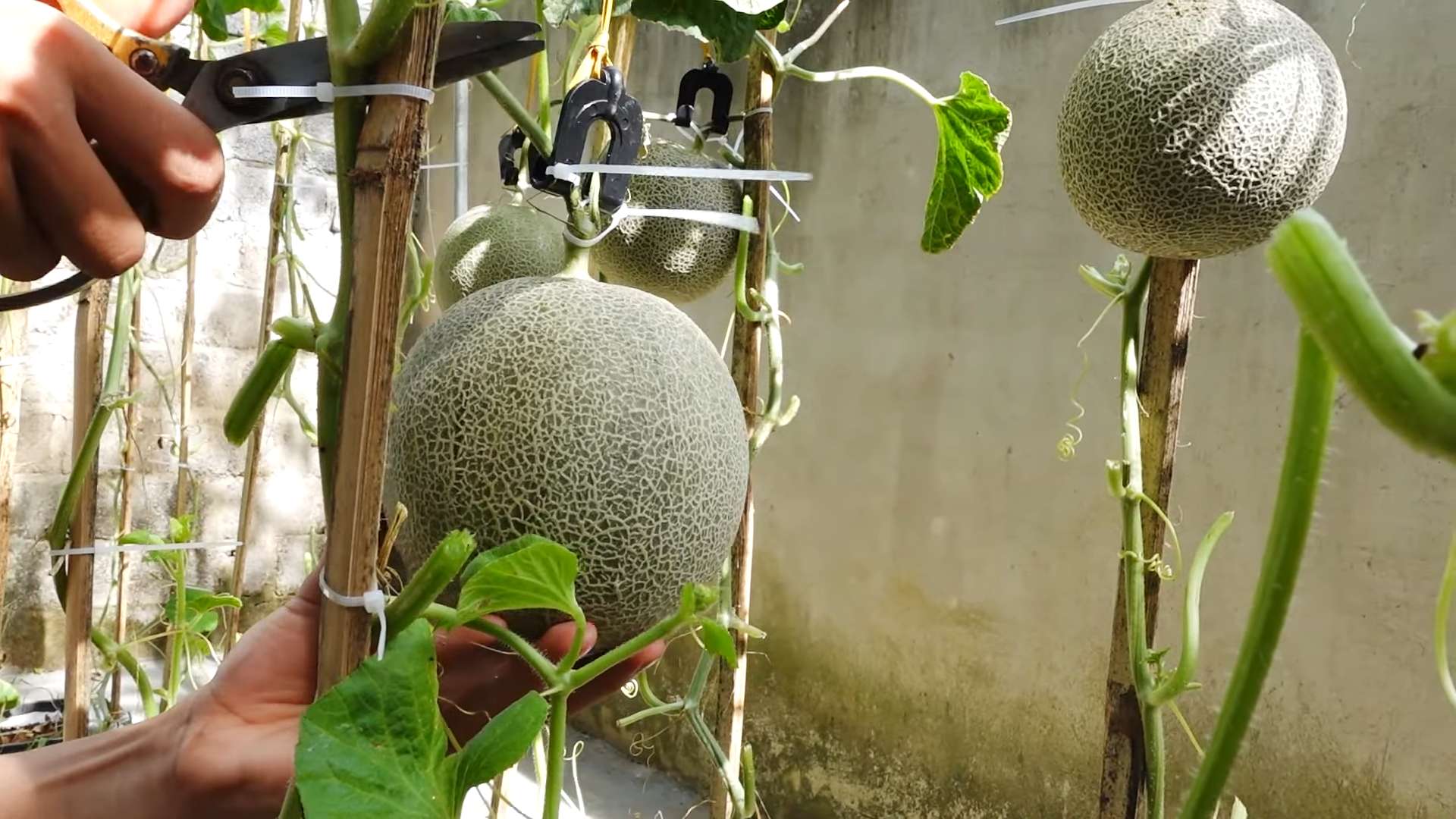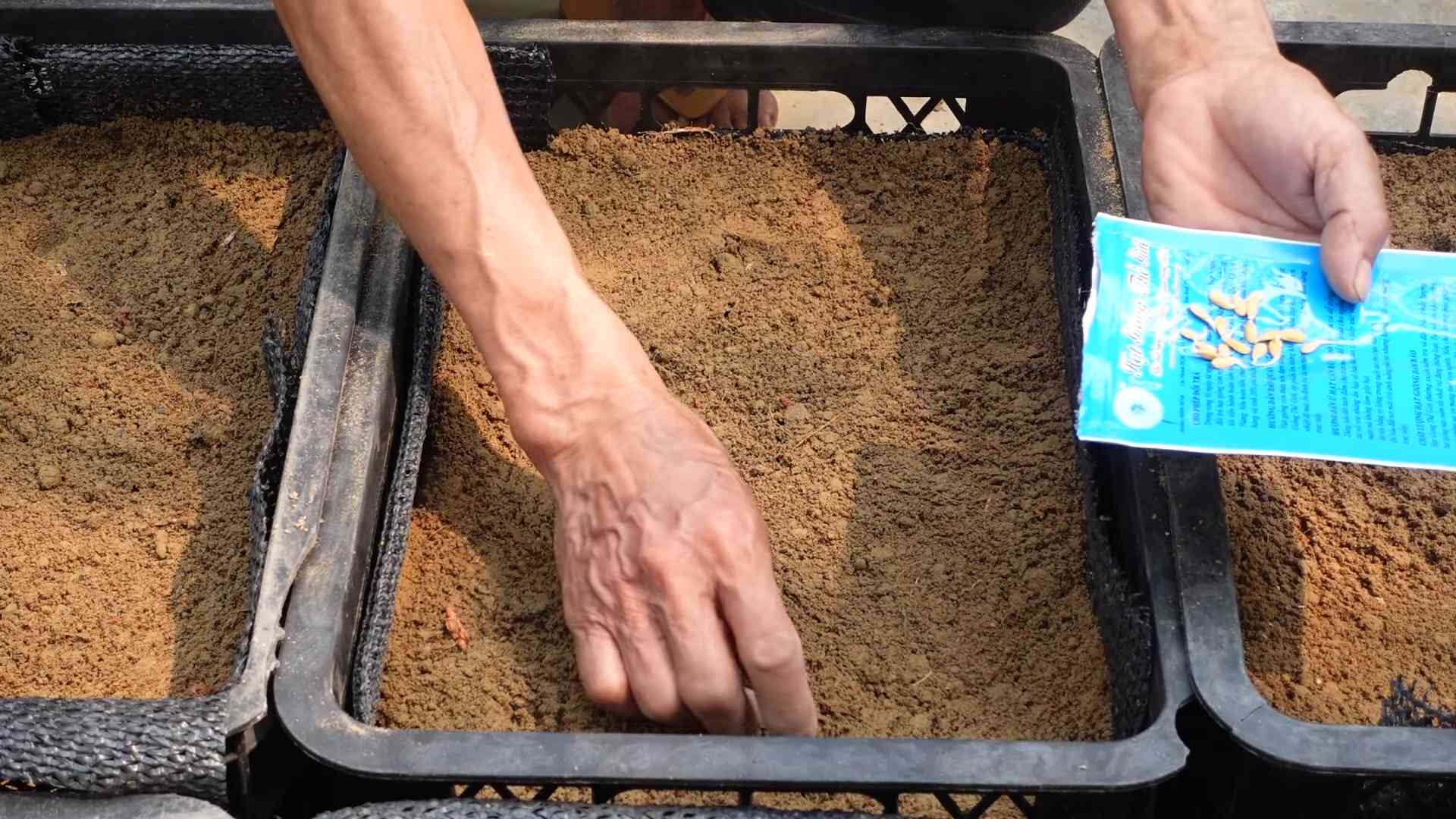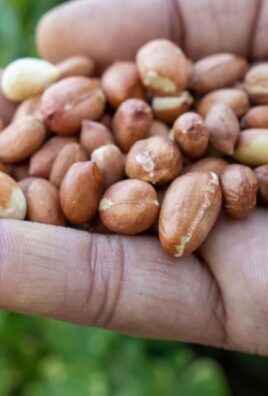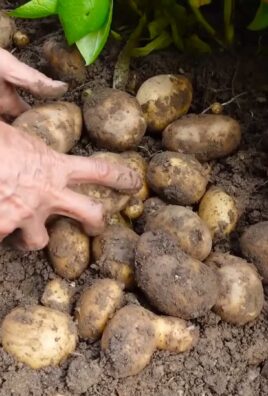Grow Cantaloupe at Home and savor the sweet taste of summer right from your backyard! Imagine biting into a juicy, sun-ripened cantaloupe that you nurtured from seed to fruit. Sounds idyllic, right? Well, it’s more achievable than you might think! For centuries, cultivating melons has been a cherished tradition, dating back to ancient Egypt and finding its way into royal gardens across Europe. Today, you don’t need a sprawling estate to enjoy this delicious treat.
Many people shy away from growing cantaloupe, believing it requires vast space and expert knowledge. But that’s where these DIY tricks come in! I’m here to debunk those myths and show you simple, effective methods to grow cantaloupe at home, even if you have limited space or a less-than-green thumb. This article is packed with easy-to-follow hacks that will help you overcome common challenges, from choosing the right variety to protecting your precious melons from pests. Get ready to transform your garden (or even your balcony!) into a cantaloupe oasis and impress your friends and family with your homegrown harvest. Let’s get started!

Grow Your Own Delicious Cantaloupe: A DIY Guide
Hey there, fellow gardening enthusiasts! Are you ready to embark on a sweet and juicy adventure? I’m talking about growing your very own cantaloupe! Trust me, nothing beats the taste of a homegrown cantaloupe, bursting with flavor and sunshine. It might seem daunting, but with a little patience and these simple steps, you’ll be enjoying cantaloupe from your backyard in no time.
Choosing the Right Cantaloupe Variety
Before we get our hands dirty, let’s talk about choosing the right cantaloupe variety. This is crucial because different varieties thrive in different climates and have varying ripening times.
* Consider your climate: If you live in a region with short summers, opt for early-maturing varieties like ‘Minnesota Midget’ or ‘Honey Girl’. For warmer climates with longer growing seasons, you have more options, such as ‘Hales Best Jumbo’ or ‘Athena’.
* Think about space: Cantaloupes need room to sprawl. If you have limited space, consider bush varieties like ‘Bush Star’ or growing them vertically on a trellis.
* Read the seed packet: Pay close attention to the information on the seed packet, including days to maturity, disease resistance, and recommended spacing.
I personally love ‘Hales Best Jumbo’ because of its classic cantaloupe flavor and reliable yields. But experiment and find what works best for you!
Starting Your Cantaloupe Seeds
You can either direct sow your cantaloupe seeds or start them indoors. I prefer starting them indoors because it gives them a head start and protects them from early-season pests and diseases.
* When to start: Start your seeds indoors about 3-4 weeks before the last expected frost.
* What you’ll need: Seed starting trays or small pots, seed starting mix, a heat mat (optional), and a grow light (optional).
Step-by-Step Instructions:
1. Prepare your seed starting trays: Fill your seed starting trays or pots with a high-quality seed starting mix. Gently moisten the mix with water.
2. Sow the seeds: Plant 2-3 seeds per cell or pot, about ½ inch deep.
3. Provide warmth: Cantaloupe seeds germinate best in warm temperatures (70-80°F). Use a heat mat to maintain consistent warmth.
4. Provide light: Once the seedlings emerge, place them under a grow light or in a sunny window. Make sure they receive at least 6-8 hours of light per day.
5. Water carefully: Keep the soil consistently moist, but not waterlogged. Water from the bottom to avoid damping off, a fungal disease that can kill young seedlings.
6. Thin the seedlings: Once the seedlings have developed their first true leaves, thin them to one strong seedling per cell or pot.
Preparing the Garden Bed
Cantaloupes are heavy feeders, so preparing the garden bed properly is essential for a bountiful harvest.
* Choose a sunny location: Cantaloupes need at least 6-8 hours of direct sunlight per day.
* Improve the soil: Cantaloupes prefer well-drained, fertile soil with a pH of 6.0-6.8. Amend the soil with compost, aged manure, or other organic matter to improve drainage and fertility.
* Consider raised beds: Raised beds warm up faster in the spring and provide excellent drainage, making them ideal for growing cantaloupes.
Step-by-Step Instructions:
1. Clear the area: Remove any weeds, rocks, or debris from the garden bed.
2. Amend the soil: Spread a 2-3 inch layer of compost or aged manure over the garden bed.
3. Till or dig: Till or dig the compost into the soil to a depth of 8-12 inches.
4. Create mounds or rows: Cantaloupes grow best on mounds or rows. Create mounds that are about 12 inches high and 2-3 feet apart. Or, create rows that are 3-4 feet apart.
5. Add fertilizer: Incorporate a slow-release fertilizer into the soil according to the package directions. I like to use a fertilizer that is specifically formulated for melons.
Transplanting Your Cantaloupe Seedlings
Once the danger of frost has passed and the soil has warmed up, it’s time to transplant your cantaloupe seedlings into the garden.
* Harden off the seedlings: Before transplanting, gradually acclimate the seedlings to outdoor conditions by exposing them to increasing amounts of sunlight and wind over a period of 7-10 days.
* Choose a calm day: Transplant on a cloudy or overcast day to minimize stress on the seedlings.
Step-by-Step Instructions:
1. Water the seedlings: Water the seedlings thoroughly before transplanting.
2. Dig holes: Dig holes in the prepared garden bed that are slightly larger than the root balls of the seedlings.
3. Carefully remove the seedlings: Gently remove the seedlings from their containers, being careful not to damage the roots.
4. Plant the seedlings: Place the seedlings in the holes and backfill with soil. Gently firm the soil around the base of the plants.
5. Water thoroughly: Water the newly transplanted seedlings thoroughly.
6. Mulch: Apply a layer of mulch around the plants to help retain moisture, suppress weeds, and regulate soil temperature. I like to use straw or shredded leaves.
Caring for Your Cantaloupe Plants
Now that your cantaloupe plants are in the ground, it’s important to provide them with the care they need to thrive.
* Watering: Cantaloupes need consistent moisture, especially during fruit development. Water deeply and regularly, especially during dry spells. Avoid overhead watering, which can promote fungal diseases. Drip irrigation is ideal.
* Fertilizing: Side-dress the plants with a balanced fertilizer every 2-3 weeks.
* Weeding: Keep the garden bed free of weeds, which can compete with the cantaloupe plants for nutrients and water.
* Pest and disease control: Monitor the plants regularly for pests and diseases. Common pests include aphids, squash bugs, and cucumber beetles. Common diseases include powdery mildew and fusarium wilt. Use organic pest and disease control methods whenever possible.
* Pollination: Cantaloupes require pollination to set fruit. If you notice that your plants are not producing fruit, you may need to hand-pollinate the flowers.
Hand-Pollination (If Needed):
1. Identify male and female flowers: Male flowers have a long, thin stem, while female flowers have a small, immature fruit at the base.
2. Collect pollen: Use a small paintbrush to collect pollen from the male flowers.
3. Transfer pollen: Gently transfer the pollen to the stigma of the female flowers.
4. Repeat: Repeat this process for several days to ensure pollination.
Training Cantaloupes on a Trellis (Optional)
If you’re short on space, you can train your cantaloupe plants to grow vertically on a trellis. This can also improve air circulation and reduce the risk of fungal diseases.
* Choose a sturdy trellis: The trellis should be strong enough to support the weight of the mature plants and fruits.
* Train the vines: As the vines grow, gently guide them up the trellis and tie them in place with soft twine or plant ties.
* Support the fruits: As the fruits develop, they may need additional support. You can use slings made from pantyhose or netting to support the fruits and prevent them from breaking off the vine.
Harvesting Your Cantaloupe
The moment we’ve all been waiting for! Knowing when to harvest your cantaloupe is key to enjoying its full flavor.
* Days to maturity: Check the seed packet for the days to maturity. This will give you a general idea of when to expect your cantaloupes to ripen.
* Look for these signs:
* The skin color changes from green to tan or yellow.
* The netting on the skin becomes more prominent and raised.
* The stem begins to crack where it attaches to the fruit.
* The cantaloupe has a sweet aroma.
* The cantaloupe slips easily from the vine with a gentle tug.
Step-by-Step Instructions:
1. Gently tug: Gently tug on the cantaloupe. If it slips easily from the vine, it’s ripe.
2. Cut the stem: If the cantaloupe doesn’t slip easily, use a sharp knife to cut the stem close to the fruit.
3. Enjoy! Wash the cantaloupe and enjoy it fresh, or store it in the refrigerator for up to

Conclusion
So, there you have it! Growing cantaloupe at home, while it might seem daunting at first, is entirely achievable with a little patience, the right techniques, and a whole lot of sunshine. We’ve walked you through the process, from selecting the perfect seeds and preparing your garden to nurturing your vines and harvesting that sweet, juicy fruit. But why should you bother with all this effort when you can simply buy a cantaloupe at the store?
The answer lies in the unparalleled flavor and satisfaction that comes from enjoying a homegrown cantaloupe. Store-bought melons are often picked before they’re fully ripe to withstand transportation and storage, resulting in a less intense flavor and a firmer texture. A homegrown cantaloupe, on the other hand, is allowed to ripen fully on the vine, developing its maximum sweetness and aroma. The difference is truly remarkable.
Beyond the superior taste, growing your own cantaloupe offers a host of other benefits. You’ll know exactly what went into your melon – no pesticides, no artificial fertilizers, just good old-fashioned sunshine, water, and care. Plus, gardening is a fantastic way to connect with nature, relieve stress, and get some exercise. And let’s not forget the bragging rights that come with serving a delicious, homegrown cantaloupe to your friends and family!
But don’t just take our word for it. We encourage you to give this DIY trick a try. Start small, perhaps with just one or two plants, and see how it goes. Experiment with different varieties of cantaloupe to find your favorite. Consider using raised beds or containers if you have limited space or poor soil. And don’t be afraid to get creative with your trellising methods – a sturdy trellis not only supports the heavy melons but also adds visual interest to your garden.
Variations and Suggestions:
* Vertical Gardening: If space is limited, consider growing your cantaloupe vertically on a trellis. This not only saves space but also improves air circulation around the plants, reducing the risk of fungal diseases.
* Companion Planting: Plant basil, marigolds, or nasturtiums near your cantaloupe to deter pests and attract beneficial insects.
* Succession Planting: Plant cantaloupe seeds every few weeks to ensure a continuous harvest throughout the summer.
* Grafting: For more advanced gardeners, consider grafting your cantaloupe onto a squash rootstock for increased disease resistance and vigor.
* Container Gardening: Choose a large container (at least 20 gallons) and a dwarf cantaloupe variety for successful container gardening.
We’re confident that you’ll find the experience of growing cantaloupe at home to be both rewarding and delicious. So, grab your seeds, get your hands dirty, and prepare to enjoy the sweetest, most flavorful cantaloupe you’ve ever tasted.
And most importantly, we want to hear about your experiences! Share your tips, tricks, and photos with us in the comments below. Let’s create a community of cantaloupe growers and learn from each other. Happy gardening!
Frequently Asked Questions (FAQ)
What is the best time to plant cantaloupe seeds?
The ideal time to plant cantaloupe seeds is after the last frost when the soil temperature has warmed to at least 65°F (18°C). In most regions, this is typically in late spring or early summer. You can start seeds indoors 3-4 weeks before the last frost to get a head start, but be sure to harden them off before transplanting them outdoors.
How much sun does cantaloupe need?
Cantaloupe requires at least 6-8 hours of direct sunlight per day to thrive. Choose a sunny location in your garden where the plants will receive ample sunlight throughout the growing season. Insufficient sunlight can result in smaller, less flavorful melons.
How often should I water my cantaloupe plants?
Water cantaloupe plants deeply and regularly, especially during hot, dry weather. Aim to keep the soil consistently moist but not waterlogged. Water at the base of the plants to avoid wetting the foliage, which can increase the risk of fungal diseases. As the melons begin to ripen, reduce watering slightly to concentrate the sugars and enhance the flavor.
What kind of soil is best for growing cantaloupe?
Cantaloupe prefers well-drained, fertile soil that is rich in organic matter. Amend your soil with compost or well-rotted manure before planting to improve drainage and fertility. A slightly acidic to neutral soil pH (6.0-7.0) is ideal.
How do I know when my cantaloupe is ripe?
There are several telltale signs that a cantaloupe is ripe and ready to harvest. The most obvious is the color of the rind, which will change from green to a tan or yellowish hue. The stem will also begin to crack and separate from the melon, a process known as “slipping.” You should also be able to smell a sweet, musky aroma emanating from the melon. Finally, the end opposite the stem should feel slightly soft and yield to gentle pressure.
What are some common pests and diseases that affect cantaloupe?
Cantaloupe plants can be susceptible to a variety of pests and diseases, including aphids, squash bugs, cucumber beetles, powdery mildew, and fusarium wilt. Regularly inspect your plants for signs of infestation or disease and take appropriate action to control them. This may include using insecticidal soap, neem oil, or fungicides. Good cultural practices, such as proper spacing, watering, and ventilation, can also help to prevent pest and disease problems.
Can I grow cantaloupe in a container?
Yes, you can grow cantaloupe in a container, but you’ll need to choose a large container (at least 20 gallons) and a dwarf or bush variety of cantaloupe. Make sure the container has drainage holes and use a high-quality potting mix. Provide adequate support for the vines, such as a trellis or stake. Container-grown cantaloupe may require more frequent watering and fertilization than those grown in the ground.
How do I pollinate cantaloupe flowers?
Cantaloupe plants have separate male and female flowers. Bees and other pollinators typically handle pollination, but if you’re not seeing many bees in your garden, you may need to hand-pollinate the flowers. To do this, use a small paintbrush to transfer pollen from the male flowers to the female flowers. Female flowers have a small, immature melon at the base, while male flowers do not.
How do I store harvested cantaloupe?
Once harvested, cantaloupe can be stored at room temperature for a few days. To extend its shelf life, store it in the refrigerator. Cut cantaloupe should be stored in an airtight container to prevent it from drying out and absorbing odors from other foods.
What are some creative ways to use homegrown cantaloupe?
Besides eating it fresh, homegrown cantaloupe can be used in a variety of delicious recipes. Try adding it to smoothies, salads, or salsas. You can also grill it, pickle it, or make cantaloupe sorbet or ice cream. The possibilities are endless!





Leave a Comment